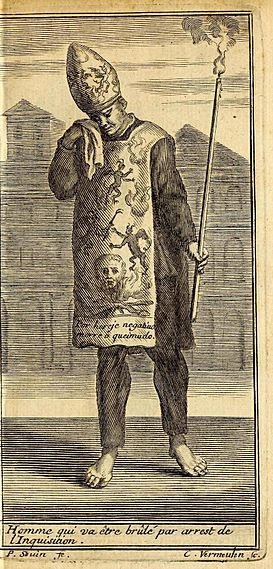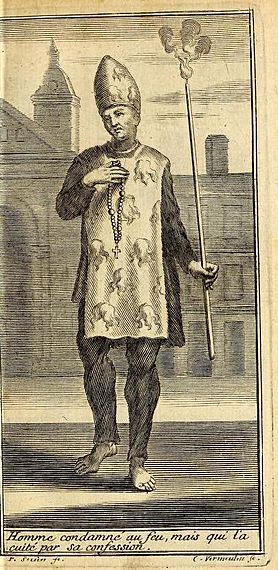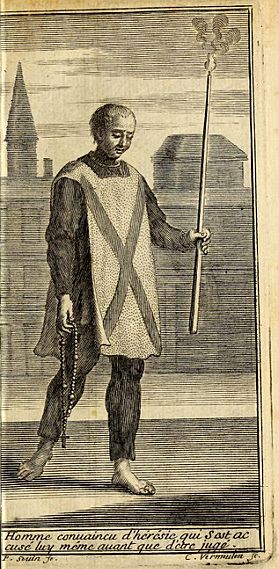Sanbenito facts for kids

The Sanbenito (pronounced san-beh-NEE-toh) was a special type of clothing used a long time ago, especially during a period called the Spanish Inquisition. It was like a scapular, which is a piece of cloth worn over the shoulders. The Sanbenito came in different colors and designs.
Some Sanbenitos were yellow with red X-shapes (called saltires). These were for people who admitted their mistakes and wanted to change. Others were black and decorated with pictures of devils and flames. These were for people who refused to change their beliefs. People wore these clothes during a public event called an auto-da-fé, which means "act of faith."
Contents
What Does Sanbenito Mean?
The name "San Benito" comes from the Spanish name for either Benedict the Moor or Benedict of Nursia. These were important religious figures.
Some people also thought the name might come from saco bendito, which means "blessed sack." However, experts later showed that this was not the true origin.
Different Kinds of Sanbenitos
There were three main types of special tunics (long shirts) that people wore when they were being punished by the Inquisition. These tunics helped show what someone was accused of and what their punishment would be.
The Samarra
The Samarra was a tunic painted with scary pictures like dragons, devils, and flames. It also had a picture of the person wearing it. This tunic meant that the person had refused to change their beliefs and would face the most serious punishment.
The Fuego Revolto
The Fuego revolto (meaning "revolving fire") was painted with flames pointing downwards. This showed that the person had changed their mind and admitted their mistakes after being found guilty. Because they confessed, they were given a less harsh punishment, though it was still very serious.
The Sambenito (with Red Crosses)
The Sambenito (the one that gave the name to all the tunics) had red X-shapes (saltires) on it. People who wore this tunic only had to do penance, which meant they had to show they were sorry for their actions, often through prayer or good deeds.
- The three sanbenitos drawn by Cornelis Vermeulen for Gabriel Dellon's ''Relation de l'inquisition de Goa'', 1688
The Coroza Cap
Along with these tunics, people also wore a tall, cone-shaped hat called a coroza (or capirote). This hat was made from the same material and had the same designs as the tunic.
Wearing the Sanbenito
People who were found guilty by the inquisitors had to walk in a public parade wearing their sambenito and coroza. They also wore a rope around their neck, carried a rosary, and held a yellow or green wax candle. This public display was meant to show everyone their punishment.
Originally, these special clothes were hung up in churches. They served as a reminder of the people who wore them and as a symbol of the Holy Inquisition's power. Lists of the punished people were also called "sambenitos." In some places, like Palma de Mallorca, families whose names appeared on these lists were treated differently, even if they were not related to the original person who wore the Sanbenito.
It's important not to confuse the Sanbenito with yellow robes worn by some monks. Monks' robes are also related to penitence, but they are different. To avoid confusion, the Inquisition chose common wool fabric dyed yellow with red crosses for the Sanbenito. Later, the inquisitors created different tunics for different types of people doing penance.
See also
 In Spanish: Sambenito para niños
In Spanish: Sambenito para niños
- Capirote
- Inquisition
- Inquisitorial system
- List of Grand Inquisitors of Spain
- Histoire de l'Inquisition en France
- Sackcloth
- Vatican Secret Archives




